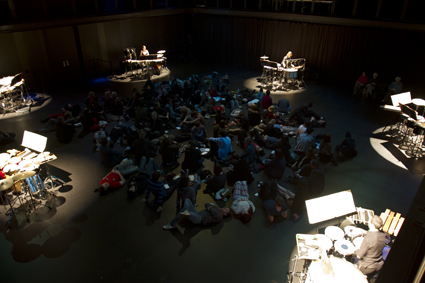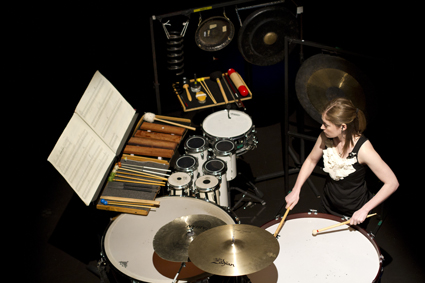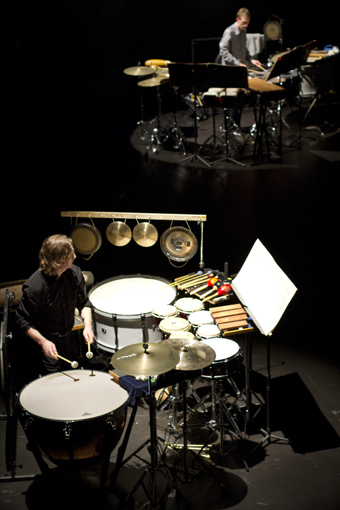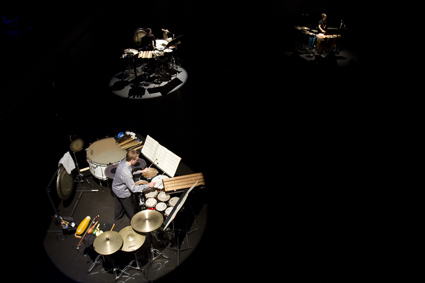expanding time, space and sounds
henry andersen: speak percussion, le noir de l’etoile, thnmf

Speak Percussion, Le Noir de l’Etoile
photo © Brad Serls
Speak Percussion, Le Noir de l’Etoile
LE NOIR DE L’ETOILE IS A WORK ABOUT SOUND IN SPACE…
Composer Gerard Grisey considered sounds as living objects—their time consisting of birth, life and death. Le Noir de L’Etoile is scored for six percussionists and tape, performed here by Melbourne’s Speak Percussion, with the musicians positioned in a circle around the performance space, audience seated in the middle. The sounds of the various gongs, drums and cymbals emanate from discrete points, move about the room, meeting in the reverberant space—their lifecycles intermingling. Grisey implements a number of dramatic spatial techniques, subtle gong sounds spill from one performer to the next, centrifugal drum rolls cycle rapidly around the players and a mess of independent tempi create a web of interlocking sound.

Speak Percussion, Le Noir de l’Etoile
photo © Brad Serls
Speak Percussion, Le Noir de l’Etoile
Visually, there is a ceremonial and communal, almost tribal aesthetic created by having audience members huddled together in semi-darkness while around them visceral and often violent percussion plays. Percussion is very gestural in comparison to most other instruments, the physical movements of the player forming a direct relationship to the sound the audience hears. With sounds appearing from all points around the audience, however, this relationship becomes confused and the results range from mesmerising to terrifying.

Speak Percussion, Le Noir de l’Etoile
photo © Brad Serls
Speak Percussion, Le Noir de l’Etoile
Le Noir de l’Etoile is a work about sound in space…
The impetus for the piece comes from a meeting between Grisey and Joe Silk, an astronomer and discoverer of the Vela Pulsar, the remnant of a long dead star whose electromagnetic fluctuations are made audible by radio receiver. This sound is taken, literally from space, and distributed via four speakers into the constructed space of the performance where it interacts with the live sound of the percussionists. In fact, the two sound sources are remarkably similar. The signal from the Vela Pulsar is so regular and percussive that it was originally believed to be a communication from alien beings. The sound of the pulsar, interacting with the tones of the percussionists, becomes another member of the ensemble.
The Speak Percussion Ensemble (Eugene Ughetti, Matthias Schack-Arnott, Peter Neville, Leah Scholes, Matthew Horsley and Louise Devenish) was truly awe-inspiring. The overriding impression of their playing was of total dynamic control: moments of still and delicate texture were interspersed with frenzied outbursts of noise without ever feeling abrupt or out of place. Even in moments of near silence there was an incredible intensity to the performance.
Underlining the spiritual and ceremonial undercurrents in his work, Gerard Grisey refers to the sound of the Vela Pulsar as “a meeting with the eternal timekeepers.” The performance then becomes a totemic celebration of this far distant sound. The resonant tones of the percussion contribute to a feeling of togetherness, the influence of something beyond the performance space. The intense, shaman-like concentration of the performers too played an important role in the overall environment in which the sounds were to live out their time.

Speak Percussion, Le Noir de l’Etoile
photo © Brad Serls
Speak Percussion, Le Noir de l’Etoile
Le Noir de l’Etoile is also a work about sound in time…
The influence of music on one’s perception of time was an area of fascination for Grisey. Sound in space and sound in time are intimately related concepts though they do differ. Sound is a way of breaking up and measuring time, just as time is a way of separating sound. There is an interesting distinction to be made between the different ways sound is experienced by players and audience.
The piece’s six performers have a difficult relationship to time in the piece. Each is sent individual click tracks while they perform, allowing mosaic-like effects of overlaid tempi. The speed of each click track is not static either; a glance at the score reveals that at points throughout the performance tempi are changing every bar. For the performer this requires intense concentration—keeping exact measurements of time in complex circumstances and over such duration is no mean feat.
For the performer an understanding of time dictates their approach to sound. For the audience however, the understanding is much more subjective, the ebb and flow of time informed by the sounds of the performance. At points of relative quiet there was a feeling of anticipation among the listeners—time lengthened by expectation. During moments of climax the raw adrenaline of the performance took over and time seemed to speed up.
Le Noir de l’Etoile is an exploration of sound, space and time.
Speak Percussion act as conduits, their imposing array of instruments sounding in sympathy with a fundamental universal rhythm. A profoundly impressive experience.
Totally Huge New Music Festival 2011: Speak Percussion, Le Noir de l’Etoile, composer Gerard Grisey, performers Eugene Ughetti (artistic director), Matthias Schack-Arnott, Peter Neville, Leah Scholes, Matthew Horsley, Louise Devenish; Studio Underground; Perth State Theatre Centre, presented by Tura New Music, Sept 15; http://www.tura.com.au/totally-huge-music-festival/about
RealTime issue #106 Dec-Jan 2011 pg. 37






